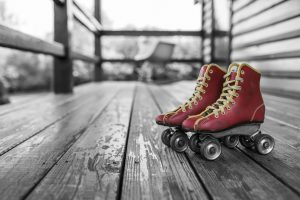
Roller skating and roller blading (also called inline skating) are fun activities for children to learn when they’re old enough. Roller skates have 4 wheels arranged in two side-by-side pairs, while roller blades/inline skates have 4 wheels in a row. Roller skates are usually used on an indoor rink and roller blades outside, though you can use both in either setting. Roller blades allow you to go faster than roller skates, but they are also less stable than roller skates, so children new to skating may prefer to start with roller skates.
Some children can start skating as young as preschool if they show interest, but remember that every child’s readiness for physical activity is different. There are roller skates designed for preschoolers with adjustable wheels you can try. Once new skaters become comfortable with standing on skates, they can try moving forward on the skates and proper stopping technique. Advanced skaters can learn more difficult techniques and may be interested in switching from roller skating to roller blading. Young skaters should always have adult supervision. Older children may not need adult supervision while skating, depending on their skill level, but they should at least skate with a friend.
Roller skating is great aerobic exercise, as it can get your heart rate up to 140-160 beats per minute, and even up to 180 beats per minute if you skate vigorously. Not only is roller skating good for your heart, but it also helps build strong muscles. It uses most muscle groups, including your glutes, quads, abs, calves, and arms. Roller skating at a moderate speed for an hour can even burn 330 calories!
Roller skaters can get hurt if they lose balance and fall down, especially when they are first learning how to skate. Wearing proper safety gear can help prevent injuries while skating. As with biking, helmets are a top priority. A bike helmet will work fine, but if your child skates often, they should wear an inline skating or skateboarding helmet which provides better protection for backward falls. The plastic on the skates should be strong enough that you can’t squeeze it. Also, make sure the brakes and wheels are not worn out and that skates are securely on the foot. Pads, long pants and shirts, gloves, and mouth guards can be especially helpful for outdoor skating to prevent scrapes if your child falls on concrete.
Children can skate on an indoor rink or outdoors, depending on what’s available and the child’s skill level and preference. When skating outside, try having children skate in areas without people or obstacles (e.g. empty parking lots, unused tennis courts, pavement with grass around it). Make sure children know to always be aware of other people and obstacles to avoid accidents and practice good etiquette while sharing an outdoor space. Children may also be interested in ice skating and sports that incorporate skating, such as hockey and roller derby.
To learn more about roller skating fundamentals, visit http://www.rollerskating.com/files_uploaded/93ea7feebe34c9bf8fad2142e90e83e6.pdf.
Have your children tried roller skating?
References